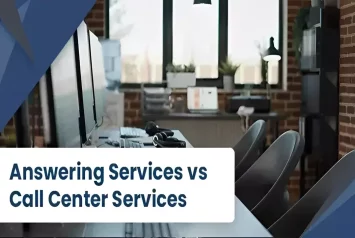What is a Call Center and how is it helping businesses?
As you hear the word call center, those sugar-coated calls from telemarketing agents must pop up in your mind, putting you in a bad mood to read the rest of this article. Hold on, as you might be perceiving it differently. A call center service deals with incoming and outgoing calls. Incoming calls are from existing customers, usually for a query or support after the purchase. Outgoing calls are strategically initiated to a set of people for sales or conveying information.
Putting it together, an inbound call center takes care of incoming calls, while the outbound call center is responsible for making outgoing calls. A company can either maintain a call center within the organization or completely outsource this function to a service provider. Also known as the call center outsourcing!
Just keep reading to absorb useful and interesting information on call centers coming up in the next paragraphs.
Types of call centers
You’ll often hear the terms what are outbound and inbound calls, so you can easily say that call centers are of two types. It means you have no idea yet about the third type, known as the blended call centers. Let’s get comfortable with all three types before we move forward.
- Inbound call centers: They receive calls from existing customers. Those customers call to:
- Ask for support when they have an issue with the product after purchase
- Inquire more information about the product or service
- Renew their subscriptions or contracts
- Register complaints and more
Customers expect the company to timely answer their calls when required. Hence a fully functional inbound department becomes an indispensable thing, particularly for large organizations with millions of customers.
Most of these inbound calls are managed by the interactive voice response system deployed to deal with common customer queries using an automated message. If the customer still needs to talk to an agent, this system routes his/her call to the most appropriate one available.
- Outbound call centers: The agents here call people for:
- Telemarketing (Marketing goods or services over a phone)
- Lead Generation
- Debt Collection
- Appointment scheduling or rescheduling
- Fundraising
- Surveying
Most commonly, the agents use an automated dialer to initiate calls which are then transferred to the available agent upon response.
- Blended call center
When a call center is equipped to deal with both inbound and outbound calls, it is considered a blended call center.
Why are call centers important?
An inbound call center is important because it will allow the company to satisfy existing customers. Since a dedicated team will be available to take the queries or resolve an issue when required.
An outbound call center is important because it brings more customers to a business. A new business will need an outbound call center to reach out to potential customers for sales and to impart information about the new product or service.
Call Centers Vs. Contact Centers
A contact center and a call center are often considered the same, but the two are slightly different. The call center relies on the telephone for both inbound and outbound calls. A customer will reach out to the company’s support department using a telephone number, while the sales agents will call on a customer’s mobile. That’s what the traditional call center environment looks like. But the emergence of technology has introduced several other options that call centers can trust as the mode of communication between agents and customers. Social media and emails are the two best examples. Therefore, when a call center relies on any or all other ways to communicate with existing customers or reach out to potential customers, it is regarded as a Contact Center.
Teams and Structure of a Call Center
The best call centers often follow this structure:
The Agents
In inbound calls, an agent is the one who connects with a customer. Similarly, in outbound calls, they represent the organization when speaking to potential customers. Hence, we can rightly say that agents are the main point of connection in call centers, and they have a good knowledge of the company.
The Team Leaders
Often in large call centers, the agents are split into smaller teams for easy management. Each of these teams has a team leader responsible for the guidance and work performed by his subordinates.
The Directors
Call center directors focus on running the overall operations of the call center. They ensure that everything is running smoothly and that the teams make the best use of their time.
Quality assurance
They check the quality of phone calls between customers and agents to ensure they adhere to the call center’s quality standards.
An organization can opt to acquire call center services in any of these forms:
- An internal call center department: A company can maintain a fully functional department internally. It will allow them the freedom to hire agents of their choice and set the standards for working.
- Outsourcing: Usually, a company outsources call center functions to expert call center service providers. Because those call centers have more experienced staff to take on these tasks. An organization can even choose to acquire call center services from offshore companies to save cost on wages.
What technology does a call center use?
A call center agent needs a computer with an uninterrupted internet connection and a good headset for a clear voice. Moreover, call center agents can also opt to invest in the latest software for:
- Call Managing
- Call Monitoring
- Speech Analytics
- Customer Relationship Management
- Outbound Dialers
- IVR
Measuring the success of a call center
Key Performance Indicators (KPIs) are mostly defined to evaluate call centers’ and agents’ effectiveness and efficiencies. They are generally different for the inbound call center and outbound call center. The KPI of the outbound call center includes:
- Total Calls Made
- Cost Per Call
- Revenue Earned
- Completed Tasks
- The KPI of the Inbound call center includes:
- First Call Resolution
- Abandoned Call Costs
- Average waiting time
Call centers across different industries
Any business that commonly interacts with customers over the phone can use call center services. Read on to know some of these businesses that are most commonly using call center services:
– Inbound call center services of airlines: A customer will usually call an airline company for:
- Flight details
- Flight statuses check
- Flight delays and cancellation inquires
– Inbound call center services for healthcare: Customers make calls to healthcare service providers for:
- Confirmation of Appointment
- Cancellation of Appointment
- Requesting to speak with a physician
Take Away
A call center deals with incoming and outgoing calls for a business. The incoming calls are usually from their customers when they have a query or need to resolve an issue with the purchase. The outgoing calls are directed to potential customers to persuade them to buy the company’s product or service. These are also termed inbound and outbound calls.
Furthermore, there’s a difference between call centers and contact centers. The latter is an evolution to the traditional call center as the agents here can also use other modes of communication, such as social media and emails, to interact with customers. An organization can hire an inbound call center if it is already established and have many customers. On the other hand, a business can hire an outbound call center if it’s new and needs to find more customers for its products or service.






